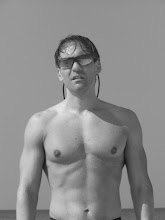I recently ran (no pun intended) across a great article on marathons and 10 reasons NOT to run in marathons. There are so many reasons not to run long distances...ever! We were not made to run long distances. Our bodies combat running long distances in a variety of ways and will do anything to protect us from doing so. Signals from our mind and bodies tell us to halt immediately.
Top Ten Reasons Not to Run Marathons, by Arthur De Vany
In light of the three deaths last week in Detroit and the two deaths the week before in marathons or half marathons, I am reposting this old post of mine on the dangers of marathoning. The readers of my private blog have known not to engage in this dangerous activity for some time. I put this post up with some sadness and take no pleasure whatsoever in these tragic and needless deaths. It is a measure of how poor the prevailing fitness advice is that so many needless deaths occur in the quest for health.
I was speaking with some of the participants in the St. George Marathon before the Senior Games. Most of them had chronic or recent injuries from their last event or from their training. There was a sense of pride among them as though they had done something to prove something about themselves. Perhaps, but there are other goals one could have that are more heathful and fulfilling. Not one of them looked really fit or healthy. Most said they had formerly been sedentary and wanted to get up and show they still had it. A few had been doing it for many years; they really looked bad, wrinkled and skinny with no muscle and poor posture. Only a few natural runners looked OK.
I told them of the risks versus benefits of marathoning and all were astonished and in total denial. I sent them to this site and told them to look for a reprise of this old post. So, here it is. Let the complaints begin.
With my apologies to David Letterman, here are the top ten reasons not to run marathons.
10. Marathon running damages the liver and gall bladder and alters biochemical markers adversely. HDL is lowered, LDL is increased, Red blood cell counts and white blood cell counts fall. The liver is damaged and gall bladder function is decreased. Testosterone decreases.
From Wu, Worl J Gastroenterol. 2004 Sep 15: 10 (18): 2711-4, “RESULTS: Total bilirubin (BIL-T), direct bilirubin (BIL-D), alkaline phosphatase (ALP), aspartate aminotransferase (AST), alanine aminotransferase (ALT) and lactate dehydrogenase (LDH) increased statistically significantly (P<0.05) the race. Significant declines (P<0.05) in red blood cell (RBC), hemoglobin (Hb) and hematocrit (Hct) were detected two days and nine days d after the race. 2 d after the race, total protein (TP), concentration of albumin and globulin decreased significantly. While BIL, BIL-D and ALP recovered to their original levels. High-density lipoprotein cholesterol (HDL-C) remained unchanged immediately after the race, but it was significantly decreased on the second and ninth days after the race. CONCLUSION: Ultra-marathon running is associated with a wide range of significant changes in hematological parameters, several of which are injury related. To provide appropriate health care and intervention, the man who receives athletes on high frequent training program high intensity training programs must monitor their liver and gallbladder function.”
9. Marathon running causes acute and severe muscle damage. Repetitive injury causes infiltration of collagen (connective tissue) into muscle fibers.
From Warhol et al Am J Pathol. 1985 Feb: 118 (2): 331-9, “Muscle from runners showed post-race ultrastructural changes of focal fiber injury and repair: intra- and extracellular edema with endothelial injury; myofibrillar lysis, dilation and disruption of the T-tubule system, and focal mitochondrial degeneration without inflammatory infiltrate (1-3 days). The mitochondrial and myofibrillar damage showed progressive repair by 3-4 weeks. Late biopsies showed central nuclei and satellite cells characteristic of the regenerative response (8-12 weeks). Muscle from veteran runners showed intercellular collagen deposition suggestive of a fibrotic response to repetitive injury. Control tissue from nonrunners showed none of these findings.”
8. Marathon running induces kidney disfunction (renal abnormalities).
From Neyiackas and Bauer, South Med J. 1981 Dec; 74 (12): 1457-60, “All postrace urinalyses were grossly abnormal…We conclude that renal function abnormalities occur in marathon runners and that the severity of the abnormality is temperature-dependent.”
7. Marathon running causes acute microthrombosis in the vascular system.
From Fagerhol et al Scan J Clin Invest. 2005; 65 (3): 211-20, “During the marathon, half-marathon, the 30-km run, the ranger-training course and the VO2max exercise, calprotectin levels increased 96.3-fold, 13.3-fold, 20.1-fold, 7.5-fold and 3.4-fold, respectively. These changes may reflect damage to the tissues or vascular endothelium, causing microthrombi with subsequent activation of neutrophils.”
6. Marathon running elevates markers of cancer. S100beta is one of these markers. Tumor necrosis factor, TNF-alpha, is another.
From Deichmann et al in Melanoma Res. 2001 June; 11 (3): 291-6. “In metastatic melanoma S100beta as well as melanoma inhibitory activity (MIA) are elevated in the serum in the majority of patients. Elevation has been found to correlate with shorter survival, and changes in these parameters in the serum during therapy were recently reported to predict therapeutic outcome in advanced disease.”
From Santos et al Life Sci. 2004 September: 75 (16): 1917:24, “After the test (a 30km run), athletes from the control group presented an increase in plasma CK (4.4-fold), LDH (43%), PGE2 6.6-fold) and TNF-alpha (2.34-fold) concentrations, indicating a high level of cell injury and inflammation.”
5. Marathon running damages your brain. The damage resembles acute brain trauma. Marathon runners have elevated S100beta, a marker of brain damage and blood brain barrier disfunction. There is S100beta again, a marker of cancer and of brain damage.
From Marchi, et al Restor Neurol Neurosci, 2003; 21 (3-4): 109-21, “S100beta in serum is an early marker of BBB openings that may precede neuronal damage and may influence therapeutic strategies. Secondary, massive elevations in S100beta are indicators of prior brain damage and bear clinical significance as predictors of poor outcome or diagnostic means to differentiate extensive damage from minor, transient impairment.” Other studies indicate confusion in post-event marathon runners.
4. Marathons damage your heart.
From Whyte, et al Med Sci Sports Ecerc, 2001 May, 33 (5) 850-1, “Echocardiographic studies report cardiac dysfunction following ultra-endurance exercise in trained individuals. Ironman and half-Ironman competition resulted in reversible abnormalities in resting left ventricular diastolic and systolic function. Results suggest that myocardial damage may be, in part, responsible for cardiac dysfunction, although the mechanisms responsible for this cardiac damage remain to be fully elucidated.”
3. Endurance athletes have more spine degeneration.
From Schmitt et al Int J Sports Med. 2005 Jul; 26 (6): 457-63, “The aim of this study was to assess bone mineral density (BMD) and degenerative changes in the lumbar spine in male former elite athletes participating in different track and field disciplines and to determine the influence of body composition and degenerative changes on BMD. One hundred and fifty-nine former male elite athletes (40 throwers, 97 jumpers, 22 endurance athletes) were studied. …Throwers had a higher body mass index than jumpers and endurance athletes. Throwers and jumpers had higher BMD (T-LWS) than endurance athletes. Bivariate analysis revealed a negative correlation of BMD (T-score) with age and a positive correlation with BMD and Kellgren score (p < 0.05). Even after multiple adjustment for confounders lumbar spine BMD is significantly higher in throwers, pole vaulters, and long- and triple jumpers than in marathon athletes.”
The number two reason not to run marathons.
2. At least four particiants of the Boston Marathon have died of brain cancer in the past 10 years. Purely anecdotal, but consistent with the elevated S100beta counts and TKN-alpha measures. Perhaps also connected to the microthrombi of the endothelium found in marathoners. [Sterling Advice note: 15,000 cases per year in U.S. general population and 10,000 deaths (.0200%) . 4 deaths in Boston Marathoners per 20,000 participants (.0033%).]
And now ladies and gentlemen the number one reason not to run marathons,
1. The first marathon runner, Phidippides, collapsed and died at the finish of his race. [ Jaworski, Curr Sports Med Rep. 1005 June; 4 (3), 137-43.]
Now there is a recommendation for a healthy activity. The original participant died in the event. But, this is not quite so unusual; many of the running and nutritional gurus of the past decade or two died rather young. Pritikin, Sheehy, Fixx, and Atkins, among many other originators of “healthy” practices died at comparatively young ages. Jack LaLanne, the only well-known guru to advocate body building, will outlive us all.
This got me thinking...
Compare a marathoner to a sprinter. What would you rather look like? Would you rather look and be healthy and strong OR unhealthy and weak?






















